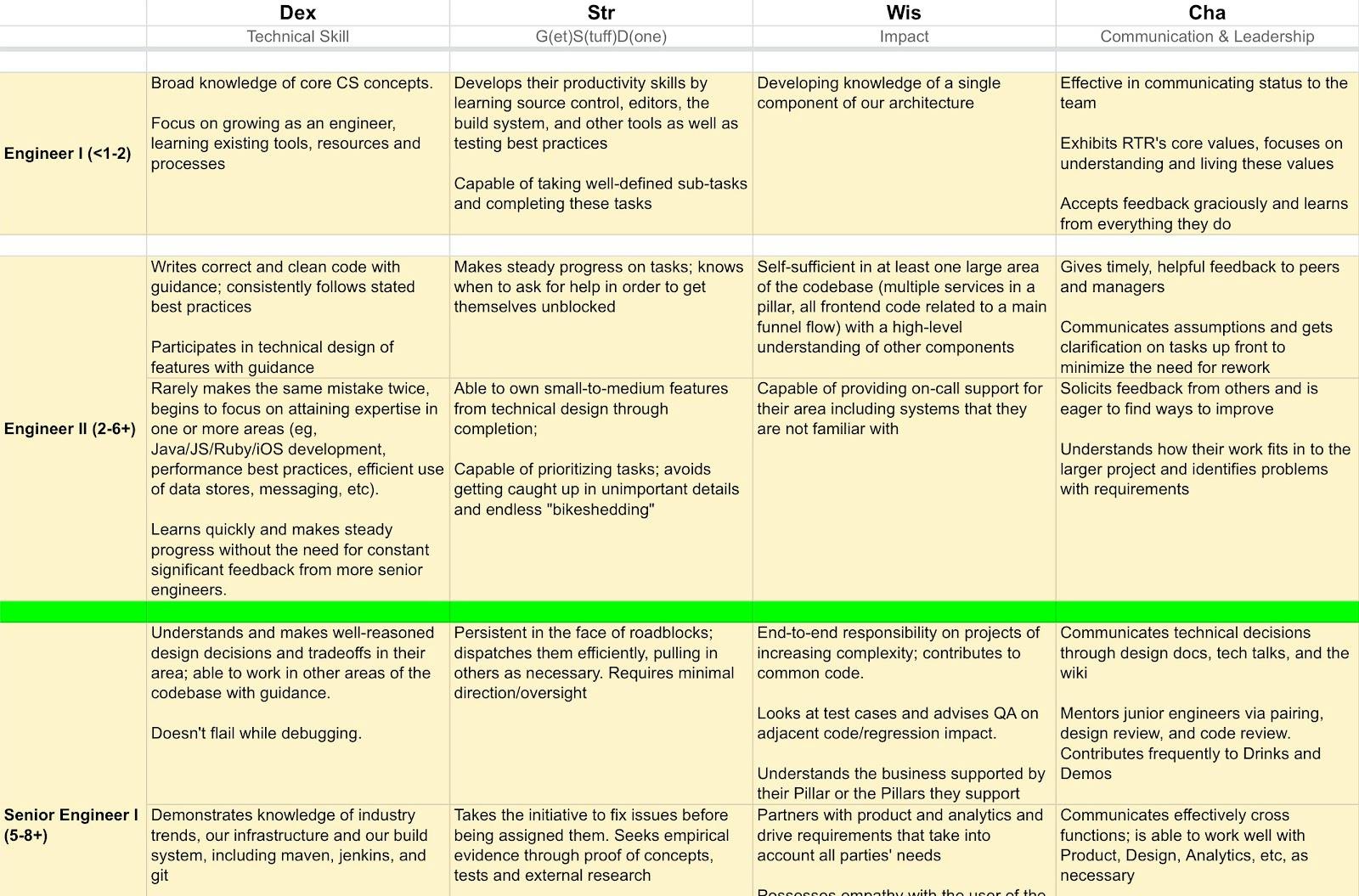Share
Explore

 Homebrew Guide to Career Ladders
Homebrew Guide to Career Ladders
How to use career ladders to recruit and retain amazing employees.
Are you a startup founder who has never had to think about career ladders? If you are growing and hiring more people, it's time to put career/job ladders in place. If you aren’t sure where to start, the Homebrew Guide to Career Ladders has arrived just in time. We will explore: what makes up a career ladder, when to implement a career ladder and how to use ladders both internally and for external recruiting purposes. As always, we welcome your feedback.
Let’s start with the basics.
What is a career ladder?
When should we create a career ladder?
When you hit approx 30-40 people and the company is at least 18-24 months old you should implement career ladders for all functions. This is around the time when you hire an HR manager who may have some experience in this area. You will have employees who have been in their respective roles at least one year and may be ready for a role with greater scope (for example, a promotion) and there need to be clear guidelines about what the next level looks like and how employees will be evaluated to determine they’ve reached that level.
Management track vs. Individual Contributor (IC) track
Some companies have rewarding career tracks for people who want to move up and stay as ICs (individual contributors). Building an option for IC career ladders (rather than pushing high performers into management tracks) may be important to retain talent.
For example, some companies provide a career path for ICs such as in the engineering function where a very senior engineer becomes a “principal engineer” vs. director or vice president. It is becoming widely used in other functions such as recruiting, product management, and sales. One major advantage of having a two track (IC and Management) system is that the people who go into management actually want to manage. Otherwise, they’d pick the IC track.
How to create a career ladder...
How many rungs in a career ladder?
It depends on the job function. The average career ladder for an IC role can be anywhere from 4-8 rungs. For management around 5-7 rungs. Engineering tends to have the most rungs at early stage companies.
How many rungs should I start with?
4 for IC roles and 5 for management roles should be safe. You can always revise as the business needs change.
Additional reading:
Example career ladders by function
Let’s explore different career tracks by function (Engineering, Design, Product, Marketing & Sales).
Note: We’ve included the necessary skills for each level of engineering. Other functions don’t include specific skills (product, marketing, design, sales)
Engineering
Management
6
Individual Contributor (IC)
6
Management
6
Individual Contributor (IC)
6
CTO
Sets company wide technical direction
VPE
Strategic role. Contributes to architectural decisions w/ focus on product & business needs.
Senior Director of Eng
More senior role of director of eng.
Director of Eng
Operational role where one manages a team of managers or engineers.
Senior Manager
More senior role of Eng. Manager
Manager
Manages a team of 5-7 engineers
Principal Engineer
Oversees the research, development, and design of engineering projects for a company or organization.
Senior Staff Engineer
More senior version of staff engineer.
Staff Engineer
Finding and implementing solutions for issues, creating new software or applications by writing code, using visual development environments to debug, and ensuring the technical architecture runs smoothly. Mentor and train other team members.
Senior Engineer/tech lead
Owns the development and rollout for an entire product, or large project. Champions process (Scrum, TDD, etc). Writes tech specs and identifies risks before starting major projects.
Engineer
Owns a functional area. Breaks large requests down into sub-tasks, gives higher-level status updates. Writes test plans. Takes operational responsibility. Sets measurable goals, and meets them. Reviews code changes.
Jr/Assoc. Engineer
Builds defined features, investigates and fixes bugs, writes tests. Communicates progress, identifies blocking issues.


Design
Product
You don’t see the Principal Product Manager as a popular title because the IC path for a PM tends to end at the Senior PM level at early stage companies. Some companies have a Group Product Manager (not shown in this chart) which is considered a balance of individual contribution and people management. Larger, later stage companies (MSFT, AMZ) tend to provide dual career tracks in product. These companies have a product area that is big enough in scope and complexity or that requires significant strategic planning.
Management
4
Individual Contributor (IC)
3
Management
4
Individual Contributor (IC)
3
Chief Product Officer
Making sure staffing resources, budget, and research are being invested in the areas that will provide the combined best benefit.
VP of Product
Budgeting for the product organization, ensuring that strategic product decisions align with business objectives, and protecting the product team from infighting and internal politics.
Sr. Director
More senior version of Director
Director
Leads all product initiatives and oversees the entire product lifecycle.
Senior PM
More senior version of PM.
PM
Identifies the customer need and the larger business objectives that a product or feature will fulfill, articulates what success looks like for a product.
APM
Collects quantitative product data, interprets consumer feedback, and develops product strategies.
Marketing
The IC career path is not typically recognized in marketing. Marketers tend to build their careers as ICs then manage others. Career growth for ICs can mean managing larger projects and managing cross functional teams vs. managing individual people. Some senior marketing folks who don’t want to lead big teams choose to work for themselves and run marketing consulting businesses. They take on different projects for companies where they are managing projects -- sometimes more than 1 at a time vs. managing people.
Management
3
Individual Contributor (IC)
2
Management
3
Individual Contributor (IC)
2
Chief Marketing Officer
1
Responsible for marketing, sales and growth strategy.
Marketing Manager
1
Establish and maintain marketing strategies.
VP of Marketing
1
Works closely with the CMO (or founder) to define, implement, and manage marketing strategy, craft messaging, review budget, and set short- and long-term goals for a company’s marketing department.
Director of Marketing
1
Manages the marketing process from research and planning to execution and analysis.
Marketing Specialist/Coordinator
1
Manage different processes and interact with numerous departments.
Sales
Sales is a function where an employee can stay an IC and successfully grow her career in most companies. Large companies tend to have more individual contributors with many years of experience who have chosen to “carry a bag” and sell themselves vs. manage a team. Sales IC’s carry a sales quota that they are experienced enough to meet or exceed regularly and that they can benefit from financially.
Management
4
Individual Contributor (IC)
3
Management
4
Individual Contributor (IC)
3
Chief Revenue Officer (CRO)
Manages all company’s revenue streams. Accountability for driving all revenue growth.
VP of Sales
Helps company scale by contributing to growth and strategy or sales org.
Director of Sales
Works with sales managers to determine sales objectives, forecast and develop sales quotas, maintain sales volume, and remain a crucial part of the hiring process
Regional Sales Manager
Leads teams of SDRs, reps, and AEs. Involved in hiring, and recruiting. Manage quotas and team goals. Coordinates sales training.
Senior AE
More senior version of AE.
Account Executive
Holds quota. Helps with presentations; identifying, surfacing, and addressing potential buying obstacles; crafting personalized value propositions; getting the commitment to purchase; and negotiating terms
SDR/BDR
Researches, prospects, and qualifies leads.
As your company grows in different functions, it is important to take time to build out career ladders for all functions where applicable. Employees need to understand their potential career choices in a company, whether they are moving towards management or individual contributor paths. It is the manager’s responsibility to discuss career development during
and make sure that employees understand the different choices they have regarding future opportunities. A ladder is an essential tool in career development for both managers on the promotion side and employees working towards a larger scope of responsibilities. Additional Resources
Last updated: 11.1.24
Want to print your doc?
This is not the way.
This is not the way.

Try clicking the ⋯ next to your doc name or using a keyboard shortcut (
CtrlP
) instead.